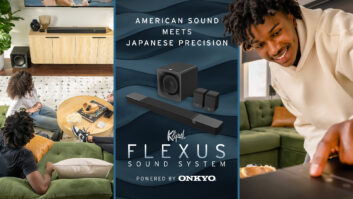After a week of post-CEDIA decompression and some semblance of catching up on all of the emails and crises that inevitably cropped up in my time away from the showroom, I’ve managed to work through the mental inventory of what I experienced at CEDIA EXPO this year.
Without a doubt, one of the most prevalent and exciting themes at the show was Dolby Atmos, and I did my best to catch all of the demos. For the record, companies I saw demonstrating Atmos included: Dolby, Marantz, Integra, Pioneer, Steinway Lyngdorf, JBL Synthesis, GoldenEar Technology, Definitive Technology, Yamaha, Triad Audio, and Procella Audio. (ADA had a demo outside of the convention center and unfortunately I didn’t get over to see it. KEF showed a new Atmos speaker module in a static display.) That means that regardless of the brands you sell or the budget levels of your installs, Atmos is something that will (I hope) revitalize and re-energize home theater sales in a way that no technology has in years.
As an integrator, Atmos should be your best friend. Get to know it, understand it, demo it, sell it, install it. Here’s a recap of the best audio demos I heard at the EXPO.
Atmos Pro Level
The most intense and over-the-top Atmos demo at EXPO was courtesy of JBL Synthesis, who brought a commercial cinema system to the show that included 39 Synthesis speakers—including 12 overheads and 16 surrounds—and eight 15-inch subwoofers driven by more than 19,000 watts of power! The SPL levels were what you would expect from that level of power, and the immersion and cohesion of hemispherical surround was truly impressive, as objects seamlessly traveled the space around the room and over your head. Because this demo was fed from a true cinema server, JBL was able to play content not restricted to the Dolby demo Blu-ray disc, a blessed relief after sitting through Enrique Iglesias’ “Bailando” more than three times in a day. I sat through JBL’s demo twice and both times everyone in the room jumped at a scene from the Gravity trailer; jolted from their seats from the sudden, concussive bass wave. Sonically, JBL Synthesis offered the closest experience to what I heard at Dolby’s commercial cinema in New York, with the “spear chuck” from Star Trek most closely tracking right past my head.
Best Real-World Atmos
While the JBL Synthesis demo was awesome in its overwhelming nature, at a cost of around $250,000, it’s a system destined for maybe 0.01 percent of home theaters. And with all of those surface-mounted speakers, only the largest and most dedicated of rooms (and understanding of spouses) would even be willing to consider such an install. At the other end of the price and equipment rainbow was the demo put on by GoldenEar Technology. This was a speaker package retailing for $10,800 that delivered an amazing Atmos presentation, with phenomenal hemispheric cohesion and tight, deep, feel-it-in-your-soul bass. Company president Sandy Gross told me he “wanted to show how good Dolby Atmos can sound when played through exceptional speakers in an optimum configuration.” What really struck me about Sandy’s demo was that he was “only” using a 5.1.4 system instead of the 7.1.4 configuration favored by almost everyone else, yet the marriage between front-to-back and floor-to-ceiling sounds was terrific, owing both to the terrific imaging of GoldenEar’s speakers and to Sandy’s meticulous set up and positioning of the speakers. I know he took a lot of care positioning the four in-ceiling Invisa HTR7000s to give the widest sweetspot and soundstage, and the results truly paid off. Sandy’s demo proved you don’t need to spend a fortune to blow a crowd away with great audio.
Affordable Atmos
For Atmos to truly be successful, the “buy in” will have to come downstream enough that pricing reaches a wide range of budgets. On the receiver side, most manufacturers are rolling out AVRs at the high-end of the line-up and most “entry-level” Atmos-capable models are selling for $1,000 and up. Onkyo is current the entry-level leader, coming in with a 5.1.2 Atmos receiver at $599, representing an easy and demonstrable upgrade at a small upcharge. On the speaker side, Pioneer demonstrated a 5.2.4 Elite speaker system that will retail for under $3,750. The speakers are designed by Andrew Jones, Pioneer’s chief speaker engineer, and the man behind the TAD Reference Ones, some of my favorite money-no-object speakers on the planet. The Pioneer SP-EFS73 floorstanders and SP-EBS73 bookshelf speakers utilize “Atmos-enhanced” drivers, meaning that no ceiling speakers are needed (perfect for condo/apartment dwellers or retro-challenged room.) Both models utilize an upward-firing coherent source transducer utilizing a 4-inch midrange and 1-inch tweeter to aim and bounce Atmos height-channel information off the ceiling over listeners’ heads. While I found Atmos-enabled speakers lacked the total overhead dimensionality of in-ceiling speakers, the Pioneers did a solid job of throwing sounds above me, and the voicing on the speakers produced audio that was clear and easy to listen to.
Existing Content Up in the Mix
Dolby is touting a new upmixer in Atmos receivers/processors that will take non-Atmos coded material from and signal—stereo to 7.1-channel— up to the installed Atmos speaker array. This is going to be important since the roll-out of Atmos-coded content will be a relative trickle at first. (I mean, sure, you can get a Dolby demo disc and just put “Bailando” on an endless loop, but I fear you’d quickly pray for the death that will not come.) Unfortunately, I didn’t hear any demos at EXPO showing off the upmixer’s capabilities, but from what I’ve heard post-EXPO from those that did get a listen, the upmixer does a terrific job of extracting these overhead channels and creates a really immersive experience without sounding overdone or artificial. This is going to be especially important for early adopters as they want to show-off their new overhead speakers.
Best New Non-Atmos Format
Lest you think that Atmos is the only new immersive sound format in town, Auro-3D was demonstrating its competing 11.1-channel audio system in one of the high-end sound rooms. This speaker setup utilizes two levels of 5-channel speakers, a traditional floor-level surround layer complemented by another 5-channel height layer, and capped with a single overhead “Voice of God” channel. The Auro-3D demo was quite impressive, having a more natural, “real-life” quality to the sound. Granted, this could have been due to the demo material selected—pipe organ in a church, nature sounds, plane flying overhead – but the Auro-3D system had a wonderful life-like quality and seems like it would be a terrific playback system for surround music. Auro-3D will be releasing its own AV receiver, the 16-channel Auriga including 13 x 200-watts of on-board power. Auro-3D’s technology is also being supported by Trinnov Audio, Datasat Digital Entertainment, and Steinway Lyngdorf.
Best Non-Atmos Surround
There were two non-Atmos, traditional speaker demonstrations I heard that were remarkable in their own right, proving you don’t need new technology and additional channels to deliver a wonderful experience. The first was Meridian’s Special Edition DSP7200SE Digital Active Loudspeakers, driven by the company’s 861V8 Reference Digital Surround Controller. The thing that most struck me about this demo was the amazing dialog clarity. With many company’s demonstrating the same Atmos material, Meridian choose the same scene from Star Trek, which features a bit of dialog from a running Captain Kirk that turns to mush on many systems. The Meridian system plucked this dialog from the background and let you easily hear every word, clear and detailed amidst the onscreen chaos. The second system that really impressed was from PRO Audio Technology, a company more known for giant—7 feet tall and pushing 300 pounds—speakers that hide behind baffle walls in massive rooms. This year the company elected to go with a 5.2-channel, entirely in-wall, speaker system driven by a single 1U rack-space amplifier. This system could easily fit into any room and be the centerpiece of a moderate-priced but incredibly impressive home theater system. With only two 5-inch in-walls handling rear audio, the system did a wonderful job of producing the virtual height sounds from Ratatouille, making it sound like water was dripping from directly above the seats.
If you saw a demo at EXPO that stood out in your mind, please share it in the comments below!
John Sciacca is principal of Custom Theater and Audio in Myrtle Beach, SC.







